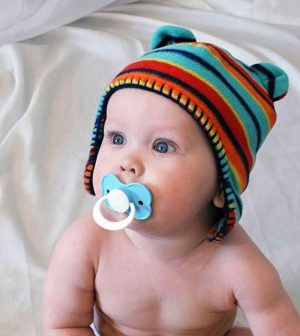- Skip Storing This Everyday Product in the Fridge Door
- Green Tea + B3 Pairing May Boost Brain Health
- Navigating Your Midlife Crisis: Embracing New Possibilities
- City Raccoons Showing Signs of Domestication
- Mapping the Exposome: Science Broadens Focus to Environmental Disease Triggers
- One Week Less on Social Media Linked to Better Mental Health
- Your Brain Changes in Stages as You Age, Study Finds
- Some Suicide Victims Show No Typical Warning Signs, Study Finds
- ByHeart Formula Faces Lawsuits After Babies Sickened With Botulism
- Switch to Vegan Diet Could Cut Your Greenhouse Gas Emissions in Half
Early Detection Is Key to Correcting Childhood Hearing Loss. Know the Signs

Early detection of childhood hearing loss is crucial but also challenging because babies can’t tell their parents or doctors exactly what’s wrong.
About 2 to 3 of every 1,000 kids is born with permanent hearing loss, so most health systems test newborns within a day or two after birth, according to Penn State Health in Hershey, Pa.
Hearing loss can be genetic, but a family may not realize they have the recessive gene trait that causes it until an affected child is born, said Jill McClelland, manager of audiology at Penn State Health.
Hearing loss in an infant can also be caused by a non-genetic illness in a mother. Infections at 20 to 25 weeks of pregnancy can affect the developing ear canal in the fetus.
Though rubella once contributed to this, today cytomegalovirus (CMV) is often a problem. While mom may have no symptoms, CMV can destroy a baby’s hearing.
“We’ve seen an uptick,” McClelland said in a health system news release.
In some babies, the cause is amniotic fluid in the ear canal; it can be removed to restore hearing.
A rare, genetic disorder called Usher Syndrome can cause hearing and vision loss over a several years.
Hearing loss can also be caused by environmental factors, such as loud noises.
“I personally have seen children where the cause has been video games and headphones,” McClelland said.
The U.S. National Institutes of Health recommends two tests for infants. In otoacoustic emissions tests, an earphone is placed in the newborn’s ear canal. It plays sounds and tests for echo responses.
In auditory brain stem response tests, electrodes are placed on the infant’s head and earphones in the ears. A machine measures the brainstem’s response.
Every baby should be tested, McClelland said. She noted that in Pennsylvania’s Hearing Screening and Intervention program, about 95% of newborns are tested. The goal: Screening them within 30 days of birth.
The program aims to diagnose hearing loss within three months and enroll the child to receive treatment and intervention by 6 months of age.
If testing doesn’t catch a hearing loss but you suspect your infant is having trouble hearing, McClelland urges you to follow up on it.
“Follow your gut,” she advised. “A hearing screening is just a screening.”
Watch for possibilities that your child might be struggling to hear, Penn State Health suggests. If you can sneak up on and startle a child easily, something may be wrong.
A child with hearing loss may have trouble pronouncing certain words. For example, if a child using a singular version of a verb or failing to recognize the S sound in a plural version of a noun, it might be a hearing issue.
Ask your pediatrician for a screening.
Medical science has made strides in its ability to supplement hearing.
Children as young as 9 months old can receive a cochlear implant. These are surgically implanted microphones, speech processors and transmitters that can improve the understanding of language and help with a child’s development.
More than 118,000 cochlear devices have been implanted in the U.S. — 65,000 of them in kids.
More information
The U.S. Centers for Disease Control and Prevention has more on hearing loss in children.
SOURCE: Penn State Health, news release, March 22, 2023
Source: HealthDay
Copyright © 2025 HealthDay. All rights reserved.










